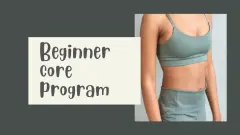There are lots of aspects to healthy living, including good diet, being active, mental wellbeing and getting enough sleep. These 25 healthy living tips that are easy to follow and will help you lead a healthier lifestyle.
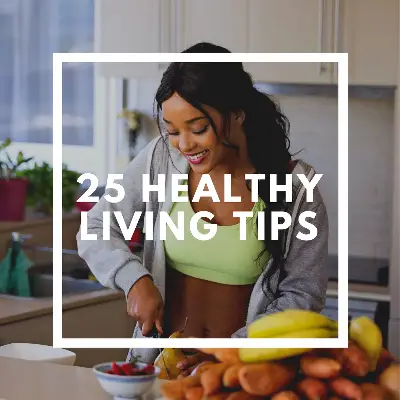
#1 Keep a food diary
#2 Try “zero calorie” snacks
#3 Eat plenty of vegetables and salad
#5 Cut down on calories from drinks
#6 Look out for hidden sugars
#7 Add beans to mince dishes and stews to cut down on the amount of meat in a portion
#8 Have a glass of juice a day
#9 Buy ready prepared frozen veg
#10 Add berries or dried fruit to your breakfast cereal
#11 Plan what time you have available and schedule your workouts
#12 Track your workouts
#13 Do more walking
#14 Make sure you warm up
#15 Stretch regularly
#16 keep your spine flexible
#17 Train the core stabilising muscles
#18 Do exercises which challenge your balance
#19 Allow adequate recovery time between workouts
#20 Always make sure you have good exercise technique
#21 The best exercise is the one you enjoy doing
#22 Go to bed and get up at the same time every day
#23 Spend time outdoors every day
#24 Reduce your stress and anxiety with relaxation techniques or meditation
#25 Avoid caffeine, alcohol & high fat foods close to bedtime
Healthy living tips 1-10 – healthy diet
#1 Keep a food diary
Keeping a food diary is a helpful first step to getting into better eating habits. It helps you to see where your calories are coming from and identify bad eating habits. Once you have completed a log for several days, it can help you to plan improvements.
#2 Try “zero calorie” snacks

Our digestive process uses a lot of calories. There are a few foods which are so low in calories and high in fibre that the net calorie gain from them is very small. This makes them good choices for snacking when you’re trying to lose weight. These foods include:
- Celery
- Raw cabbage
- Cucumber
- Raw mushroom
- Raw carrots
- Tomatoes
#3 Eat plenty of vegetables and salad
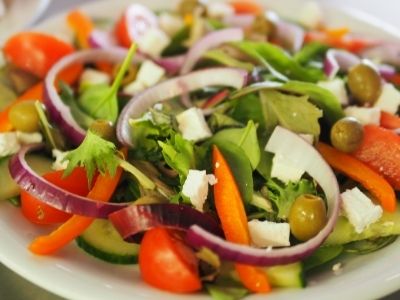
This will keep your vitamin and mineral intake up and provide plenty of fibre, without adding too many calories. (Not too much fruit though – it’s much higher in calories because of its sugar content.)
#5 Cut down on calories from drinks
Keep a log of everything you drink for a few days and then add up how many calories are coming from your drinks – this may be surprisingly high. For example, fruit juices have quite a lot of sugar, canned drinks have even more, milky drinks contain fat and sugar and alcoholic drinks are very high in calories. Ways to cut down:
- Fruit juice can be diluted 50/50 with sparkling water or soda water.
- Likewise, mixing white wine with soda to make a spritzer will cut down on calorie intake and help avoid alcohol dehydration.
- Obviously cutting down on sugar in hot drinks will reduce calories, as will making milky drinks from skimmed milk.
- Having hot drinks without sugar can be difficult if you’re used to having sugar, so it’s easier to cut down gradually.
- Add chopped fruit or cucumber to water for a low calorie drink.
The best drink is plain water of course, but this isn’t always very appetising and it’s nice to have other drinks.
#6 Look out for hidden sugars
Sugar is in lots of foods that appear to be savoury and/or healthy. Examples are breakfast cereals, salad dressings and soups. Check all labels for sugar content and bear in mind in may not be listed as sugar. Here are some of the alternative names for sugar:

#7 Add beans to mince dishes and stews to cut down on the amount of meat in a portion
Beans are a good way to make a small amount of meat go further. As well as being low fat, they are high in fibre and protein so will leave you feeling full.
#8 Have a glass of juice a day

Juice counts as a 5 a day portion and can be a good way of getting a variety of super food nutrients into your diet. For example, watermelons are usually very large and aren’t the easiest fruit to prepare, so drinking a glass of watermelon juice is a good alternative.
#9 Buy ready prepared frozen veg
Ingredients like chopped onions, peppers, mushrooms, carrots and sweet potato are handy for quick and easy stir-fries, soups and curries.
#10 Add berries or dried fruit to your breakfast cereal

Another quick and easy way to get one of your 5 a day in. Berries don’t need any prep (apart from washing of course). Dried fruit is a concentrated source of fibre and nutrients and will keep for months in the store cupboard.
Healthy living tips 11-21 being active and working out
#11 Plan what time you have available and schedule your workouts
You may think you don’t have time to exercise, but if you spend some time thinking about your weekly schedule, you can probably find some slots. You don’t need to do an hour long workout – 10 or 15 minute sessions all add up.
#12 Track your workouts
Keeping an exercise diary is known to help with motivation. Keeping track of whether or not you do your exercise sessions can help you to see if there are patterns that stop you from exercising. Make a note of your scheduled time, whether you did the session and if not, why not. Review this at the end of the week to help you schedule the following week’s sessions.
#13 Do more walking
Walking is a great way to exercise and we all have opportunities to get in more walking every day. Short trips to the stores, school runs, lunchtime walks, getting off the bus or train a stop early, parking further away and taking the stairs instead of the lift are all ways to get more steps in.
#14 Make sure you warm up
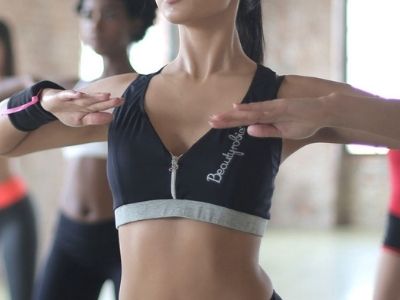
Even if you’re on a tight schedule, you shouldn’t miss out warming up. Body tissues need to adapt to the effort of a workout. If they don’t get the chance to do this, then the workout will be less effective and could result in injury. During the warm-up, various changes happen in the body which prepare it for the more vigorous exercise to follow:
- Joint mobility exercises stimulate the joints to produce the fluid which lubricates them. This allows for smooth movement and cushioning of impact.
- The heart starts to beat faster to improve blood supply to the working muscles, which provides them with oxygen and nutrients and removes carbon dioxide.
- The muscles become warmer and more flexible
- Breathing rate increases
- Coordination improves
#15 Do some stretching
It’s not good to have tight muscles. This is because they will restrict movement and make injury more likely. In order to maintain flexibility, muscles need to be stretched to their full length regularly. For most people, this isn’t something that happens in normal everyday activity. In fact, many people have jobs in which they don’t move much at all, or use the same muscles in repetitive movements. Regular stretching will therefore help to stop muscles getting tight and problems developing. After exercise is a good time to stretch, because the muscles are warm – stretching cold muscles can result in injury.
#16 keep your spine flexible

As well as stretching your muscles, you should do exercises to keep your spine supple (see the resource list below). The discs in our spines rely on exercise to keep them soft and spongy. When these discs become hard and brittle, the spine becomes inflexible.
#17 Train the core stabilising muscles
Doing curl ups will train your 6-pack muscles, but it’s the muscles underneath these that pull the abdominal area in. This means that you need to work these muscles to get flat abs. There are lots of ways to train the deeper muscles, but you need to start with learning how to maintain neutral pelvis.
#18 Do exercises which challenge your balance
Challenging balance is good for core strength and coordination. Exercises which challenge balance include:
- Any exercise where the weight is on one leg, for example knee lifts, side leg lifts, high kicks etc.
- Movements where the weight is on the toes, for example calf raises, squats with heels raised
- Stability ball work
- Balance board and Bosu work
#19 Allow adequate recovery time between workouts
Improvements to fitness happen between workouts, not while we’re exercising. Ideally, you should allow at least 48 hours before doing the same type of exercise again. You can, however, do something different in between. So for example, you could alternate strength workouts with running.
#20 Always make sure you have good exercise technique
Being sloppy with exercise technique increases the chance of injury and, depending on the type of exercise you’re doing, can make it less effective. Always follow any instructions you’re given, use a mirror if one is available and focus on your movement control.
#21 The best exercise is the one you enjoy doing
You’re far more likely to stick to an exercise program in the long term if it’s something you enjoy. Some people are highly disciplined and enjoy pushing themselves, but most find it difficult to maintain motivation to do something they don’t enjoy. Running may be better for cardio health than walking, for example, but isn’t necessarily the right choice if you hate running and prefer walking. Try different types of exercise and stick with the one you like best.
Healthy living tips 22-25 mental wellbeing and sleep
#22 Go to bed and get up at the same time every day

This helps your body clock get into a routine and know when it’s time to sleep.
#23 Try to spend time outdoors
Ideally, do some exercise outdoors. Both exercising and being outdoors are good for mental and physical health. Taking a walk outdoors each day will help you to feel more calm and relaxed, as well as improving your fitness.
#24 Reduce your stress and anxiety with relaxation techniques or meditation

Although exercising outdoors and doing activities you enjoy can make you feel more calm and happy, if you suffer from stress and anxiety taking time to specifically focus on relaxation may help. There are many different types of relaxation exercises and meditations. As with physical exercise, you should try different ones and find what you like best.
#25 Avoid these foods and drinks close to bedtime

What we eat and drink in the evening can affect how long it takes us to go to sleep and our quality of sleep. Try to avoid the following:
- Caffeine is a stimulant and it takes several hours for all traces of caffeine to leave the body, so it is best not to have any food or drink containing caffeine in the evening. Common caffeine-containing foods/drinks include coffee, tea, chocolate and cola.
- Alcohol is a depressant. It may help you to fall asleep initially, but can cause sleep disturbances later on in the night.
- High fat foods take a long time to digest and so shouldn’t be eaten close to bedtime.
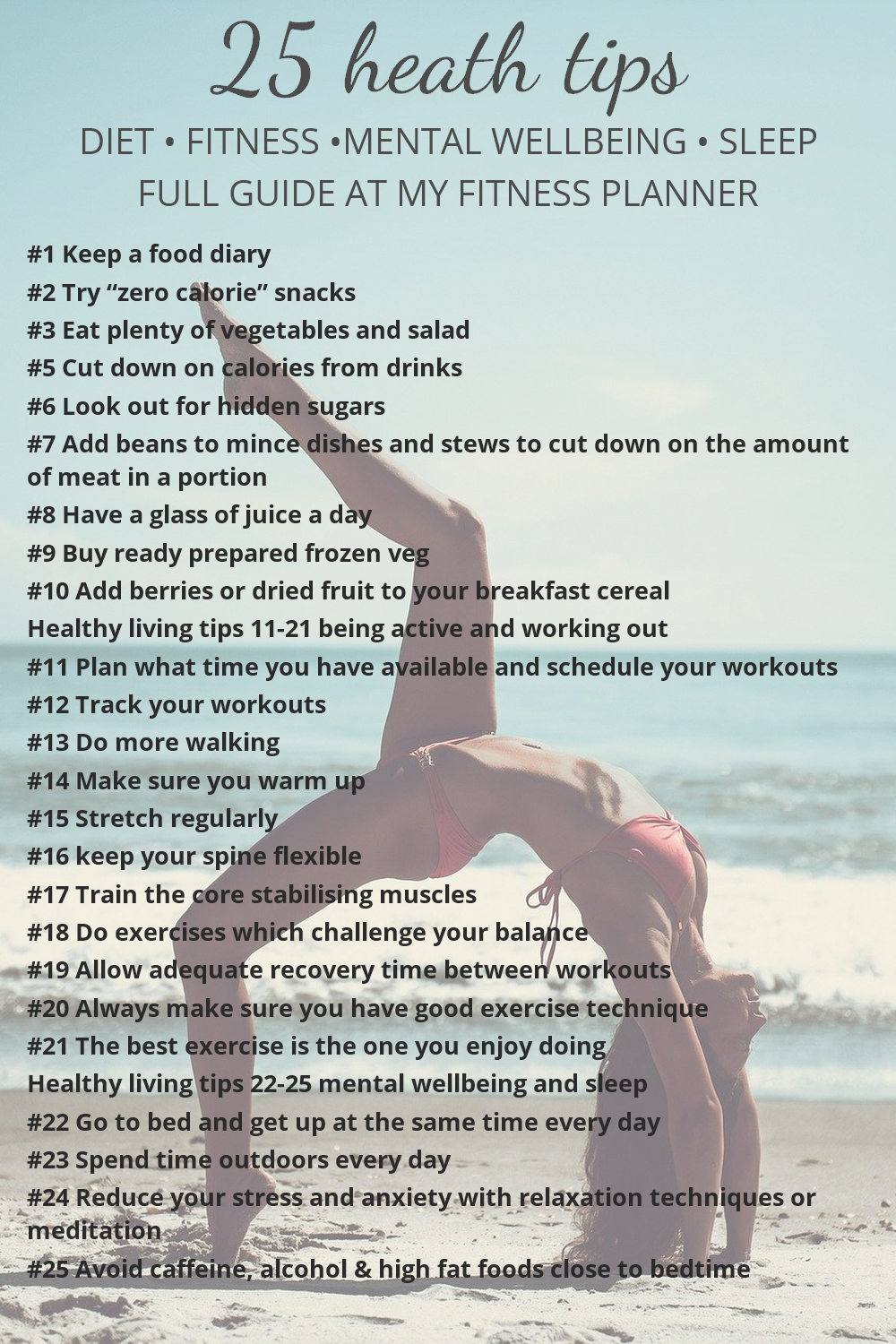
More about healthy living
Healthy diet:


